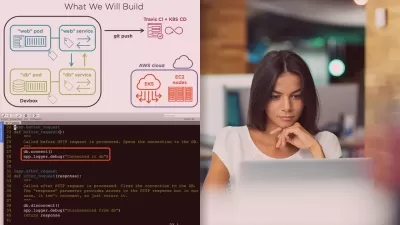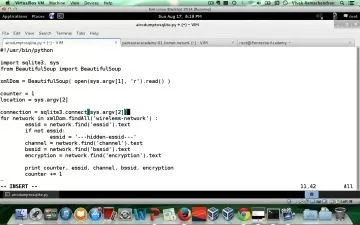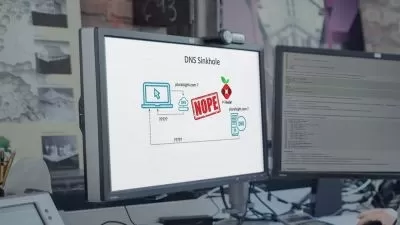Mastering 5G PHY: Complete Development Training
Sakshama Ghoslya
19:00:40
Description
5G, Physical Layer, 3GPP, Training
What You'll Learn?
- OFDM & basics of wireless communication
- Understanding of essential and advance modules in 5G Physical Layer
- SSBurst: PSS, SSS and PBCH
- PDCCH: Physical Downlink Control Channel understanding
- PDSCH: Physical Downlink Shared Channel understanding
- CSI-RS: Channel State Information Reference Signal understanding
- DMRS: Demodulation Reference Signal for DL and UL channels
- PRACH: Physical Random Access Channel understanding
- PUCCH: Physical Uplink control channels (F0, F1, F2, F3, F4)
- PUSCH: Physical Uplink Shared Channel understanding
- SRS: Sounding Reference Signal understanding
- PTRS: Phase Tracking Reference Signal understanding
- Power Control in DL and UL
- MIMO: Multiple Input and Multiple Output Antenna systems
- Understanding of Physical Layer 3GPP specification
Who is this for?
What You Need to Know?
More details
DescriptionCourse is currently under draft. Please come back after 25-Sept-2024
Become a Physical Layer Expert with 5G PHY Development Training Program
Dive into the cutting-edge world of 5G technology with our comprehensive training on the 5G Physical Layer (PHY). Designed for both beginners and experienced professionals, this training program will guide you through the intricacies of 5G PHY, from foundational concepts to advanced techniques.
What You'll Learn:
3GPP Standards: Understand the crucial role of the 3rd Generation Partnership Project (3GPP) in shaping 5G technology and how its standards influence network architecture and performance.
Basic Modules of the Physical Layer: Explore the core components of 5G PHY, including modulation, coding, signal processing techniques, PN sequence, ZC sequence, and antennas that are part of the physical layer channels and signals.
SSBurst (Synchronization Signal Burst): Learn about synchronization signal bursts and their significance in 5G networks for facilitating initial access and mobility management.
PDCCH (Physical Downlink Control Channel): Gain insights into the PDCCH transmitter and receiver chains, CORESET, search space, blind decoding, and DCIs.
PDSCH (Physical Downlink Shared Channel): Master the workings of the PDSCH transmitter and receiver chains, MCS, transport blocks, and MIMO.
CSI-RS (Channel State Information Reference Signal): Understand how CSI-RS aids in channel estimation and optimization for enhanced data throughput and network efficiency.
DMRS (Demodulation Reference Signal): Explore the DMRS and its function in improving the accuracy of data demodulation and overall signal quality.
PUCCH (Physical Uplink Control Channel): Delve into the various formats of PUCCH and how they support uplink control information transmission.
PRACH (Physical Random Access Channel): Discover the PRACH and its role in facilitating random access procedures and initial connection setups in 5G networks.
PUSCH (Physical Uplink Shared Channel): Learn about the workings of the PUSCH transmitter and receiver chains, resource allocation, MCS, transport blocks, and MIMO.
SRS (Sounding Reference Signal): Understand the purpose of SRS in uplink channel sounding and its impact on beamforming and link adaptation.
PTRS (Phase Tracking Reference Signal): Explore the role of PTRS in phase noise compensation and its effect on maintaining signal integrity.
HARQ (Hybrid Automatic Repeat reQuest): Grasp the concepts of HARQ for error correction and how it enhances data reliability and throughput.
Additional Topics: Expand your knowledge with bonus content like RSRP, RSRQ, ARFCN, GSCN, PAPR, and more.
Who this course is for:
- 3G/4G/5G Engineers working in testing field and wants to be developer
- 4G/5G Engineer working in L2/MAC field and wants to be MAC expert
- 4G/5G Physical Layer Engineer who wants to build in depth understanding
- 4G/5G Radio Network Optimization Engineers
- Graduating students who are looking for jobs in 4G/5G/6G field
- Freshers who wants to switch their jobs to core 4G/5G/6G field
Course is currently under draft. Please come back after 25-Sept-2024
Become a Physical Layer Expert with 5G PHY Development Training Program
Dive into the cutting-edge world of 5G technology with our comprehensive training on the 5G Physical Layer (PHY). Designed for both beginners and experienced professionals, this training program will guide you through the intricacies of 5G PHY, from foundational concepts to advanced techniques.
What You'll Learn:
3GPP Standards: Understand the crucial role of the 3rd Generation Partnership Project (3GPP) in shaping 5G technology and how its standards influence network architecture and performance.
Basic Modules of the Physical Layer: Explore the core components of 5G PHY, including modulation, coding, signal processing techniques, PN sequence, ZC sequence, and antennas that are part of the physical layer channels and signals.
SSBurst (Synchronization Signal Burst): Learn about synchronization signal bursts and their significance in 5G networks for facilitating initial access and mobility management.
PDCCH (Physical Downlink Control Channel): Gain insights into the PDCCH transmitter and receiver chains, CORESET, search space, blind decoding, and DCIs.
PDSCH (Physical Downlink Shared Channel): Master the workings of the PDSCH transmitter and receiver chains, MCS, transport blocks, and MIMO.
CSI-RS (Channel State Information Reference Signal): Understand how CSI-RS aids in channel estimation and optimization for enhanced data throughput and network efficiency.
DMRS (Demodulation Reference Signal): Explore the DMRS and its function in improving the accuracy of data demodulation and overall signal quality.
PUCCH (Physical Uplink Control Channel): Delve into the various formats of PUCCH and how they support uplink control information transmission.
PRACH (Physical Random Access Channel): Discover the PRACH and its role in facilitating random access procedures and initial connection setups in 5G networks.
PUSCH (Physical Uplink Shared Channel): Learn about the workings of the PUSCH transmitter and receiver chains, resource allocation, MCS, transport blocks, and MIMO.
SRS (Sounding Reference Signal): Understand the purpose of SRS in uplink channel sounding and its impact on beamforming and link adaptation.
PTRS (Phase Tracking Reference Signal): Explore the role of PTRS in phase noise compensation and its effect on maintaining signal integrity.
HARQ (Hybrid Automatic Repeat reQuest): Grasp the concepts of HARQ for error correction and how it enhances data reliability and throughput.
Additional Topics: Expand your knowledge with bonus content like RSRP, RSRQ, ARFCN, GSCN, PAPR, and more.
Who this course is for:
- 3G/4G/5G Engineers working in testing field and wants to be developer
- 4G/5G Engineer working in L2/MAC field and wants to be MAC expert
- 4G/5G Physical Layer Engineer who wants to build in depth understanding
- 4G/5G Radio Network Optimization Engineers
- Graduating students who are looking for jobs in 4G/5G/6G field
- Freshers who wants to switch their jobs to core 4G/5G/6G field
User Reviews
Rating
Sakshama Ghoslya
Instructor's Courses
Udemy
View courses Udemy- language english
- Training sessions 89
- duration 19:00:40
- Release Date 2024/10/02










